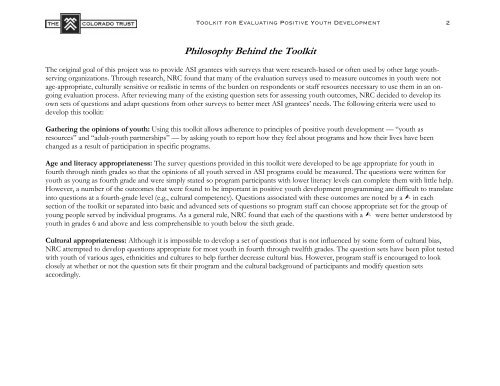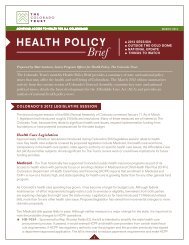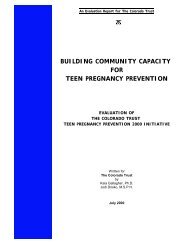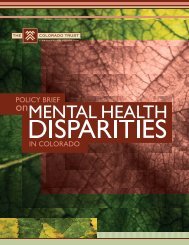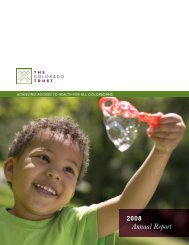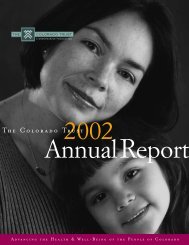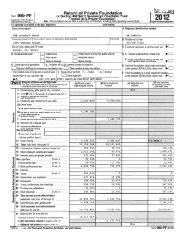After-School Initiative's Toolkit for Evaluating
After-School Initiative's Toolkit for Evaluating
After-School Initiative's Toolkit for Evaluating
You also want an ePaper? Increase the reach of your titles
YUMPU automatically turns print PDFs into web optimized ePapers that Google loves.
<strong>Toolkit</strong> <strong>for</strong> <strong>Evaluating</strong> Positive Youth Development 2<br />
Philosophy Behind the <strong>Toolkit</strong><br />
The original goal of this project was to provide ASI grantees with surveys that were research-based or often used by other large youthserving<br />
organizations. Through research, NRC found that many of the evaluation surveys used to measure outcomes in youth were not<br />
age-appropriate, culturally sensitive or realistic in terms of the burden on respondents or staff resources necessary to use them in an ongoing<br />
evaluation process. <strong>After</strong> reviewing many of the existing question sets <strong>for</strong> assessing youth outcomes, NRC decided to develop its<br />
own sets of questions and adapt questions from other surveys to better meet ASI grantees’ needs. The following criteria were used to<br />
develop this toolkit:<br />
Gathering the opinions of youth: Using this toolkit allows adherence to principles of positive youth development — “youth as<br />
resources” and “adult-youth partnerships” — by asking youth to report how they feel about programs and how their lives have been<br />
changed as a result of participation in specific programs.<br />
Age and literacy appropriateness: The survey questions provided in this toolkit were developed to be age appropriate <strong>for</strong> youth in<br />
fourth through ninth grades so that the opinions of all youth served in ASI programs could be measured. The questions were written <strong>for</strong><br />
youth as young as fourth grade and were simply stated so program participants with lower literacy levels can complete them with little help.<br />
However, a number of the outcomes that were found to be important in positive youth development programming are difficult to translate<br />
into questions at a fourth-grade level (e.g., cultural competency). Questions associated with these outcomes are noted by a in each<br />
section of the toolkit or separated into basic and advanced sets of questions so program staff can choose appropriate set <strong>for</strong> the group of<br />
young people served by individual programs. As a general rule, NRC found that each of the questions with a were better understood by<br />
youth in grades 6 and above and less comprehensible to youth below the sixth grade.<br />
Cultural appropriateness: Although it is impossible to develop a set of questions that is not influenced by some <strong>for</strong>m of cultural bias,<br />
NRC attempted to develop questions appropriate <strong>for</strong> most youth in fourth through twelfth grades. The question sets have been pilot tested<br />
with youth of various ages, ethnicities and cultures to help further decrease cultural bias. However, program staff is encouraged to look<br />
closely at whether or not the question sets fit their program and the cultural background of participants and modify question sets<br />
accordingly.


